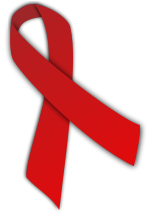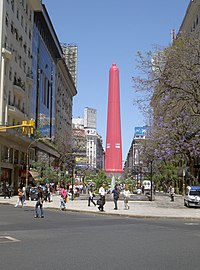
World AIDS Day
| World AIDS Day | |
|---|---|
 The red ribbon is the global symbol for solidarity with HIV-positive people and those living with AIDS.
| |
| Observed by | All UN Member States |
| Type | International |
| Date | 1 December |
| Frequency | Annual |
| First time | 1988 (1988) |
World AIDS Day, designated on 1 December every year since 1988, is an international day dedicated to raising awareness of the AIDS pandemic caused by the spread of HIV infection and mourning those who've died of the disease. The acquired immunodeficiency syndrome (AIDS) is a life-threatening condition caused by the human immunodeficiency virus (HIV). The HIV virus attacks the immune system of the patient and reduces its resistance to other diseases. Government and health officials, non-governmental organizations, and individuals around the world observe the day, often with education on AIDS prevention and control.
World AIDS Day is one of the eleven official global public health campaigns marked by the World Health Organization (WHO), along with World Health Day, World Blood Donor Day, World Immunization Week, World Tuberculosis Day, World No Tobacco Day, World Malaria Day, World Hepatitis Day, World Antimicrobial Awareness Week, World Patient Safety Day and World Chagas Disease Day.
As of 2020, AIDS has killed 36.3 million (between 27.2 million and 47.8 million) people worldwide, and an estimated 37.7 million people are living with HIV, making it one of the most important global public health issues in recorded history. Thanks to recent improved access to antiretroviral treatment in many regions of the world, the death rate from AIDS epidemic has decreased by 64% since its peak in 2004 (1.9 million in 2004, compared to 680 000 in 2020).
History
World AIDS Day was first conceived in August 1987 by James W. Bunn and Thomas Netter, two public information officers for the Global Programme on AIDS at the World Health Organization in Geneva, Switzerland. Bunn and Netter took their idea to Dr. Jonathan Mann, Director of the Global Programme on AIDS (now known as UNAIDS). Mann liked the concept, approved it, and agreed with the recommendation that the first observance of World AIDS Day should be on 1 December 1988. Bunn, a former television broadcast journalist from San Francisco, had recommended the date of 1 December that believing it would maximize coverage of World AIDS Day by western news media, sufficiently long following the US elections but before the Christmas holidays.
In its first two years, the theme of World AIDS Day focused on children and young people. While the choice of this theme was criticized at the time by some for ignoring the fact that people of all ages may become infected with HIV, the theme helped alleviate some of the stigma surrounding the disease and boost recognition of the problem as a family disease.
The Joint United Nations Programme on HIV/AIDS (UNAIDS) became operational in 1996, and it took over the planning and promotion of World AIDS Day. Rather than focus on a single day, UNAIDS created the World AIDS Campaign in 1997 to focus on year-round communications, prevention and education. In 2004, the World AIDS Campaign became an independent organization.
Each year since 1988, Popes have released a greeting message for patients and doctors on World AIDS Day. In 2016, a collection of HIV and AIDS-related NGOs (including Panagea Global AIDS and the AIDS and Rights Alliance for Southern Africa) started a campaign to rename World AIDS Day to World HIV Day. They claim the change will emphasize social justice issues, and the advancement of treatments like pre-exposure prophylaxis.
In the US, the White House began marking World AIDS Day with the iconic display of a 28 foot (8.5 m) AIDS Ribbon on the building's North Portico in 2007. White House aide Steven M. Levine, then serving in President George W. Bush's administration, proposed the display to symbolize the United States' commitment to combat the world AIDS epidemic through its landmark PEPFAR program. The White House display, now an annual tradition across four presidential administrations, quickly garnered attention, as it was the banner, sign or symbol to prominently hang from the White House since the Abraham Lincoln administration.
Since 1993, the President of the United States has made an official proclamation for World AIDS Day (see section #US Presidential Proclamations for World AIDS Day for copies of those proclamations). On 30 November 2017, President Donald Trump proclaimed World AIDS Day for 1 December.
Themes
All the World AIDS Day campaigns focus on a specific theme, chosen following consultations with UNAIDS, WHO, and a large number of grassroots, national and international agencies involved in the prevention and treatment of HIV/AIDS. As of 2008, each year's theme is chosen by the Global Steering Committee of the World AIDS Campaign (WAC).
For each World AIDS Day from 2005 through 2010, the theme was "Stop AIDS. Keep the Promise", designed to encourage political leaders to keep their commitment to achieving universal access to HIV/AIDS prevention, treatment, care, and support by the year 2010.
As of 2012, the multi-year theme for World AIDS Day is "Getting to Zero: Zero new HIV infections. Zero deaths from AIDS-related illness. Zero discrimination." The US Federal theme for the year 2014 was "Focus, Partner, Achieve: An AIDS-Free Generation".
The themes are not limited to a single day but are used year-round in international efforts to highlight HIV/AIDS awareness within the context of other major global events including the G8 Summit, as well as local campaigns like the Student Stop AIDS Campaign in the UK.
World AIDS Day Themes


| No | Year | Theme | Aspect of Note |
|---|---|---|---|
| 1 | 1988 | Communication | The first year celebrated and the first time with UN recognition. |
| 2 | 1989 | Youth | |
| 3 | 1990 | Women and AIDS | |
| 4 | 1991 | Sharing the Challenge | |
| 5 | 1992 | Community Commitment | |
| 6 | 1993 | Time to Act | |
| 7 | 1994 | AIDS and the Family | |
| 8 | 1995 | Shared Rights, Shared Responsibilities | |
| 9 | 1996 | One World. One Hope. | |
| 10 | 1997 | Children Living in a World with AIDS | |
| 11 | 1998 | Force for Change: World AIDS Campaign With Young People | |
| 12 | 1999 | Listen, Learn, Live: World AIDS Campaign with Children & Young People | |
| 13 | 2000 | AIDS: Men Make a Difference | |
| 14 | 2001 | I Care. Do You? | |
| 15 | 2002 | Stigma and Discrimination | |
| 16 | 2003 | Stigma and Discrimination | |
| 17 | 2004 | Women, Girls, HIV and AIDS | |
| 18 | 2005 | Stop AIDS. Keep the Promise | |
| 19 | 2006 | Stop AIDS. Keep the Promise – Accountability | |
| 20 | 2007 | Stop AIDS. Keep the Promise – Leadership | |
| 21 | 2008 | Stop AIDS. Keep the Promise – Lead – Empower – Deliver | |
| 22 | 2009 | Universal Access and Human Rights | |
| 23 | 2010 | Universal Access and Human Rights | |
| 24 | 2011 | Getting to Zero | |
| 25 | 2012 | Together We Will End AIDS | |
| 26 | 2013 | Zero Discrimination | Via this day's "Zero Discrimination" campaign, UNAIDS launched the first UN "Zero Discrimination Day" held on 1 March 2014 |
| 27 | 2014 | Close the Gap | |
| 28 | 2015 | On the Fast Track to End AIDS | |
| 29 | 2016 | Hands up for #HIVprevention | |
| 30 | 2017 | My Health, My Right | |
| 31 | 2018 | Know your Status | |
| 32 | 2019 | Communities Make the Difference |
Wikispore has a related page:
Event:World AIDS Day 2019
|
| 33 | 2020 | Global Solidarity Shared Responsibility | Described as "like no other", due to COVID-19. |
| 34 | 2021 | End inequalities. End AIDS. End pandemics. (UN) Ending the HIV Epidemic: Equitable Access, Everyone’s Voice (US) |
|
| 35 | 2022 | Equalize |
See also
- AIDS Awareness Week
- List of LGBTIQ+ awareness periods
- National AIDS Testing Day (United States)
- Epidemiology of HIV/AIDS
- World Health Day
- Day Without Art
- HIV.gov
- World AIDS Vaccine Day
External links
- World AIDS Day – UK site
- The World AIDS Campaign
- World AIDS Day Campaign – WHO Eastern Mediterranean Region
- World Aids Day posters from the AIDS Posters Collection – UCLA Library
- The ILO's Getting to Zero at the workplace campaign
US Presidential Proclamations for World AIDS Day
-
 2017 Proclamation
2017 Proclamation
-
 2016 Proclamation
2016 Proclamation
- 2015 Proclamation
- 2014 Proclamation
- 2013 Proclamation
- 2012 Proclamation
- 2011 Proclamation
- 2010 Proclamation
-
 2009 Proclamation
2009 Proclamation
-
 2008 Proclamation
2008 Proclamation
-
 2007 Proclamation
2007 Proclamation
-
 2006 Proclamation
2006 Proclamation
-
 2005 Proclamation
2005 Proclamation
- 2004 Proclamation
- 2003 Proclamation
- 2002 Proclamation
- 2001 Proclamation
-
 2000 Proclamation
2000 Proclamation
- 1999 Proclamation Archived 25 July 2001 at the Wayback Machine
-
 1998 Proclamation
1998 Proclamation
- 1997 Proclamation
- 1996 Proclamation
- 1995 Proclamation
-
 1994 Proclamation
1994 Proclamation
-
 1993 Proclamation
1993 Proclamation

